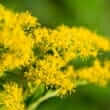Background
- Goldenrod is native to Europe, and there are many different species of goldenrod that possess the same medicinal properties. Frequently, many species, such as Solidago canadenis, Solidago gigantea, Solidago serotina, Solidago odora, Solidago nemoralis, Solidago radiata, and Solidago spathulata, along with many others are used interchangeably with Solidago virgaurea. This monograph primarily discusses the species of goldenrod Solidago virgaurea.
- Goldenrod is used as an anti-inflammatory treatment for cystitis (inflammation of the bladder), urethritis (inflammation of the uretha), and arthritis. Goldenrod has also been used to help prevent kidney stones. Traditionally, goldenrod has been used as a diuretic. Although there is currently no available human data to support this use, animal studies have indicated that goldenrod may indeed have diuretic effects. Traditionally, goldenrod has also been used as "irrigation therapy," taken along with excess fluids to increase urine flow in the treatment of diseases of the lower urinary tract.
- Although currently there are no quality human trials that have studied the effects of goldenrod, animal studies show promise in inflammation and tumors.
References
Natural Standard developed the above evidence-based information based on a thorough systematic review of the available scientific articles. For comprehensive information about alternative and complementary therapies on the professional level, go to . Selected references are listed below.
- Bader G, Plohmann B, Hiller K, et al. Cytotoxicity of triterpenoid saponins. Part 1: Activities against tumor cells in vitro and hemolytical index. Pharmazie 1996;51(6):414-417.
View Abstract - Bader G, Seibold M, Tintelnot K, et al. Cytotoxicity of triterpenoid saponins. Part 2: Relationships between the structures of glycosides of polygalacic acid and their activities against pathogenic Candida species. Pharmazie 2000;55(1):72-74.
View Abstract - Bader G, Wray V, Hiller K. The main saponins from the aerial parts and the roots of Solidago virgaurea subsp. virgaurea. Planta Med 1995;61(2):158-161.
View Abstract - Borchert VE, Czyborra P, Fetscher C, et al. Extracts from Rhois aromatica and Solidaginis virgaurea inhibit rat and human bladder contraction. Naunyn Schmiedebergs Arch Pharmacol 2004;369(3):281-286.
View Abstract - Choi SZ, Choi SU, Lee KR. Phytochemical constituents of the aerial parts from Solidago virga-aurea var. gigantea. Arch Pharm Res 2004;27(2):164-168.
View Abstract - Chrubasik S, Pollak S. [Pain management with herbal antirheumatic drugs]. Wien.Med Wochenschr. 2002;152(7-8):198-203.
View Abstract - El Ghazaly M, Khayyal MT, Okpanyi SN, et al. Study of the anti-inflammatory activity of Populus tremula, Solidago virgaurea and Fraxinus excelsior. Arzneimittelforschung 1992;42(3):333-336.
View Abstract - Gross SC, Goodarzi G, Watabe M, et al. Antineoplastic activity of Solidago virgaurea on prostatic tumor cells in an SCID mouse model. Nutr Cancer 2002;43(1):76-81.
View Abstract - Plohmann B, Bader G, Hiller K, et al. Immunomodulatory and antitumoral effects of triterpenoid saponins. Pharmazie 1997;52(12):953-957.
View Abstract - Prosser I, Phillips AL, Gittings S, et al. (+)-(10R)-Germacrene A synthase from goldenrod, Solidago canadensis; cDNA isolation, bacterial expression and functional analysis. Phytochemistry 2002;60(7):691-702.
View Abstract - Sampson JH, Phillipson JD, Bowery NG, et al. Ethnomedicinally selected plants as sources of potential analgesic compounds: indication of in vitro biological activity in receptor binding assays. Phytother Res 2000;14(1):24-29.
View Abstract - Schatzle M, Agathos M, Breit R. Allergic contact dermatitis from goldenrod (Herba solidaginis) after systemic administration. Contact Dermatitis 1998;39(5):271-272.
View Abstract - Strehl E, Schneider W, Elstner EF. Inhibition of dihydrofolate reductase activity by alcoholic extracts from Fraxinus excelsior, Populus tremula and Solidago virgaurea. Arzneimittelforschung 1995;45(2):172-173.
View Abstract - Uter W, Nohle M, Randerath B, et al. Occupational contact urticaria and late-phase bronchial asthma caused by compositae pollen in a florist. Am J Contact Dermat. 2001;12(3):182-184.
View Abstract - Zhang J, Zhang X, Lei G, et al. A new phenolic glycoside from the aerial parts of Solidago canadensis. Fitoterapia 9-23-2006;
View Abstract







